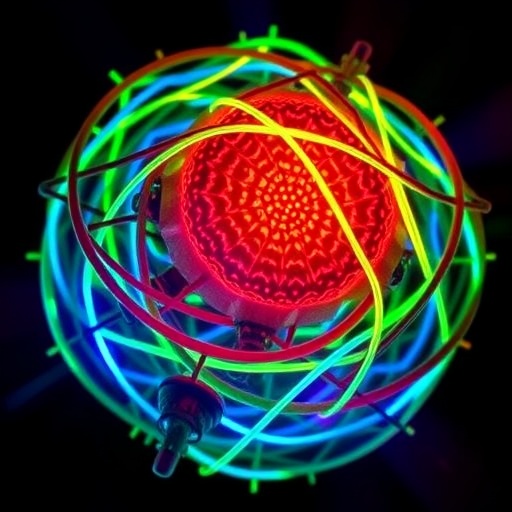In a remarkable leap forward for cellular imaging, researchers at Nanjing University of Science and Technology have pioneered an adaptive optics-assisted technique that enables long-term, high spatiotemporal resolution 3D imaging by seamlessly integrating fluorescence microscopy and intensity diffraction tomography. This groundbreaking method, coined AO-FIDT, addresses a critical bottleneck in live-cell imaging, overcoming challenges associated with time-dependent aberrations and focal drifts that have historically limited observation durations and image fidelity.
Cells, primarily composed of aqueous environments with low refractive-index contrast, have long puzzled scientists striving to reveal their intricate internal architectures using conventional microscopy. Traditional fluorescence microscopy, despite its specificity, suffers from phototoxicity and photobleaching, rendering it less ideal for prolonged imaging sessions. Conversely, Intensity Diffraction Tomography (IDT), a label-free approach, circumvents these issues by exploiting the inherent refractive-index distributions of cellular structures, but it too grapples with environmental instabilities and optical aberrations over extended periods.
The innovation by Prof. Chao Zuo and his team leverages an iterative ptychographic algorithm at the heart of AO-FIDT to disentangle three-dimensional refractive index distributions from fluctuating wavefront aberrations. By directly extracting these parameters from unlabeled intensity images, the system dynamically adjusts its point spread function in real time, correcting distortions that would otherwise obscure or degrade fluorescence data. This synchronization of aberration correction across both imaging modalities enables sustained, high-fidelity 3D reconstructions.
At its core, AO-FIDT redefines the synergy between label-free imaging and molecular specificity. While IDT provides comprehensive structural maps by harnessing intrinsic optical properties, fluorescence microscopy complements this by labeling specific biomolecules. Traditionally, merging these modalities faced significant hurdles, especially in maintaining image stability during prolonged acquisitions. AO-FIDT’s adaptive optics framework ensures that both modalities remain corrected and aligned, preserving clarity and spatial accuracy throughout extended experiments.
The system’s efficacy was demonstrated using the self-developed ZRICON 3000 dual-modal microscope, which employs a ring-shaped illumination strategy meticulously matched to the numerical aperture. This configuration achieved an unprecedented lateral resolution of 175 nanometers and an axial resolution of 775 nanometers, capturing volumetric data at 7.5 volumes per second across sizeable cellular samples. By supplementing IDT with axial fluorescence stacks, the researchers further enhanced image fidelity and delineation of subcellular components.
One of the most compelling showcases of AO-FIDT’s robustness is its stability in the face of environmental perturbations, such as thermal drift and mechanical vibrations intrinsic to laboratory settings. These factors often induce wavefront distortions that disrupt the fidelity of fluorescence and diffraction tomography data, complicating long-term monitoring of live cells. AO-FIDT circumvents these issues by real-time aberration tracking and correction, enabling continuous visualization of dynamic organelle behavior without signal degradation.
The implications of this technology are vast. Cells’ dynamic processes—ranging from organelle morphology shifts to intracellular trafficking—unfold over hours or days, necessitating imaging modalities that combine resolution, specificity, and temporal continuity. AO-FIDT answers this call by providing a non-invasive, adaptable platform capable of capturing this complexity, empowering researchers to decode subtle phenotypic changes correlated with health, disease, or therapeutic interventions.
Looking ahead, the research team envisions integrating super-resolution techniques such as Structured Illumination Microscopy (SIM) with AO-FIDT. SIM offers enhanced spatial resolution and minimal phototoxicity, promising to reveal biomolecular arrangements with unprecedented detail. By combining SIM’s capabilities with AO-FIDT’s dual-modal and adaptive optics strengths, future systems could visualize complex subcellular architectures—like mitochondrial cristae—and their alterations in real time, deepening our understanding of cellular physiology.
AO-FIDT represents a paradigm shift in computational microscopy, exemplifying how advanced algorithms coupled with adaptive optics can transcend traditional hardware constraints. This innovation aligns with a broader trend toward computational methods that refine image quality and resolution post-acquisition or in real time, enhancing accessibility and usability in biomedical laboratories worldwide.
Professor Zuo emphasizes the unique virtue of this computational approach, stating that the method achieves sustained, high-resolution imaging without necessitating complex hardware modifications or extensive post-processing. This not only streamlines experimentation but also democratizes access to cutting-edge imaging, potentially accelerating discoveries across cell biology, pharmacology, and nanomedicine.
Beyond basic research, AO-FIDT’s non-invasive, label-free modality holds promise for translational applications including drug screening, cellular diagnostics, and in situ monitoring of therapeutic responses. The ability to track cellular morphology and molecular markers over time with minimal perturbation could revolutionize personalized medicine and cellular therapies.
In sum, AO-FIDT stands as a transformative technology in the microscopy landscape, bridging the gap between structural clarity and molecular insight with unmatched stability over extended periods. This dual-modal, adaptive optics-enabled strategy not only refines the visualization of cellular secrets but also opens new horizons for long-term live-cell studies, potentially catalyzing breakthroughs in biology and medicine.
Subject of Research:
Imaging analysis
Article Title:
Adaptive Optics-Assisted Long-Term 3D Fluorescence and Intensity Diffraction Tomography for High Spatiotemporal Resolution Cellular Imaging
News Publication Date:
7-Aug-2025
Web References:
http://dx.doi.org/10.1002/lpor.202570059
References:
Zhou, N., Zhang, R., Zhu, R., Zhou, Z., Wu, H., Chen, Q., Sun, J., & Zuo, C. (2025). Adaptive Optics-Assisted Long-Term 3D Fluorescence and Intensity Diffraction Tomography for High Spatiotemporal Resolution Cellular Imaging. Laser & Photonics Reviews, 19(15). DOI: 10.1002/lpor.202570059.
Image Credits:
Ning Zhou et al., Nanjing University of Science and Technology, Nanjing, China
Keywords
Cell biology, Microscopy, Imaging, Computational biology, Optics, Biomedical engineering, Biotechnology, Nanotechnology
Tags: 3D live-cell imagingadaptive optics in microscopyAO-FIDT imaging methodfluorescence microscopy limitationshigh spatiotemporal resolution imagingintensity diffraction tomography applicationsiterative ptychographic algorithm in imaginglong-term cellular imaging techniquesNanjing University of Science and Technology researchovercoming optical aberrationsphototoxicity in microscopyrefractive index distribution analysis





